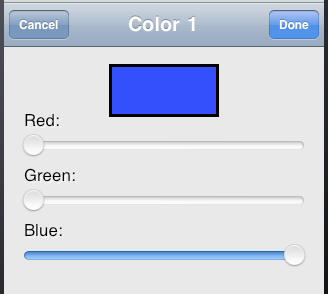Dialog Alternatives
Alert views and actions sheets are limited, inflexible, and inappropriate to any but the simplest cases. In more complex situations, it really isn’t that much work to implement an alternative.
On the iPhone, the main alternative is to navigate to a new screenful of interface. This might be by way of a navigation interface, or using a presented view (Chapter 19). For example, in the Zotz! app, in the Settings view, when the user taps a color, I summon a presented view, using a UIViewController subclass of my own, ColorPickerController (Figure 26-5).

On the desktop, the color picker in Figure 26-5 might be presented as a secondary window acting as a dialog. On the small iPhone screen, where there are no secondary windows, the presented view is the equivalent of a dialog. Indeed, one might argue that the action sheet shown in Figure 26-2 is not a very appropriate use of an action sheet; it’s intrusive and has too many buttons. It might have been better if I’d designed my own presented view. I probably picked an action sheet because it required just a few lines of code; basically, I was being lazy.
On the iPad, a popover is virtually a secondary window, and can be truly modal. An action sheet is usually presented as a popover, but it’s limited, and you don’t get access to the popover controller; in many cases, ...
Get Programming iOS 6, 3rd Edition now with the O’Reilly learning platform.
O’Reilly members experience books, live events, courses curated by job role, and more from O’Reilly and nearly 200 top publishers.

